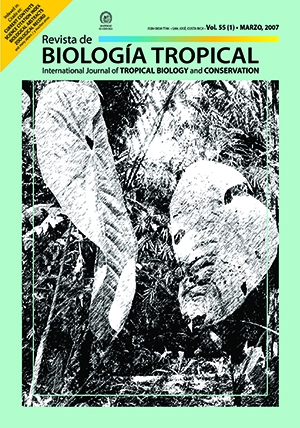Abstract
The fluctuations of the number, biomass and composition of the heterotrophic community were studied daily for two days, according to depth, pH, Eh, O2 and organic carbon concentration within a zone of the canal between the Coyuca de Benítez lagoon (Guerrero, Mexico) and the coastal waters. At the three moments of the day studied (6 am, 2 pm and 10 pm), the oxygen concentrations in the overlying water and in the superficial sediment layer were near air-saturation in the diurnal samplings (582 μM at 6 am and 665 μM at 2 pm), and sub-satured during the night (158 μM). In the sediments, the models of vertical distribution of Eh and organic carbon distributions were very irregular due to the bio-perturbation of the benthic, meio- and macrofauna, whose activity allows the superficial organic carbon to migrate towards sediment deeper layers. Vertical distribution of the different viable bacteria populations seems to be related to the hydrodynamic patterns of the communicating canal and sediments heterogeneity. In the sediment column, the heterotrophic bacteria total number varied from 6.8 to 20.3 x 108 cells cm-3. The highest heterotrophic bacterial biomass values were encountered during the diurnal samplings (39.2 μgC.l-1 at 6 am and 34.4 μgC.l-1 at 2 pm) and the lowest during the night (9.7 μgC.l-1). The fluctuations of viable heterotrophic bacteria populations with different respiratory metabolisms (aerobic, microaerophilic and anaerobic) can be explained by the existence of suboxic microniches that appear when particles of sediment are resuspended due to the water circulation and the benthic infauna excavating activity, that allows the supernatant water oxygen to penetrate through its galleries towards deeper sediment zones. The statistical analysis (Multiple lineal regression model r2≥ 0.5) showed that the on the whole, the hydrological parameters are not influence over the bacterial number and bacterial biomass distribution (r2≤ 0.5), Nevertheless, the variations of the heterotrophic bacteria community observed in the two days sampling, seem to be governed (with F-values of 0.6 to 0.9) by the irregular flows of bio-available organic material and the sediment porosity.##plugins.facebook.comentarios##

This work is licensed under a Creative Commons Attribution 4.0 International License.
Copyright (c) 2007 Revista de Biología Tropical
Downloads
Download data is not yet available.






